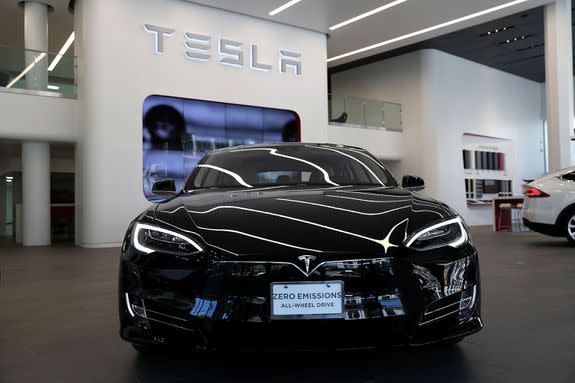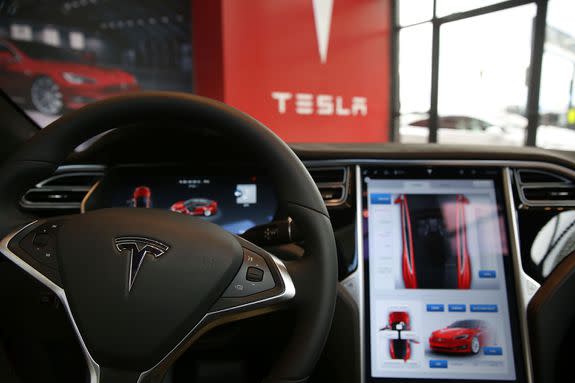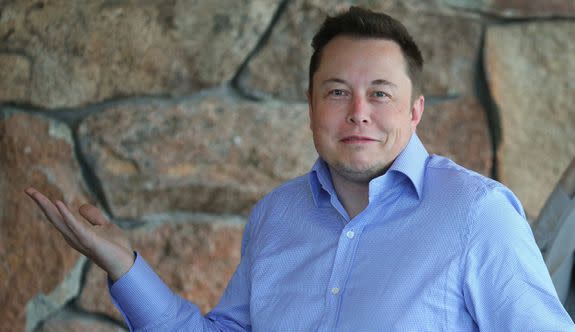Trump wants to kill the energy program that helped make Tesla what it is today

President Donald Trump wants to swing a heavy ax at government programs for innovative clean energy technologies — including an initiative that once backed Tesla.
Trump's budget proposal, unveiled on Thursday, would eliminate a major loan program that helped Tesla roll out its all-electric Model S. The costly but zero-emissions sedan later fueled Tesla's rise as one of the world's largest electric automakers.
SEE ALSO: Hawaiian island gets a huge renewable energy boost thanks to Tesla
The Advanced Technology Vehicle Manufacturing (ATVM) program is one of dozens of climate-related initiatives that Trump has placed on his chopping block.
This probably shouldn't come as a surprise, given the fact that on Thursday, an administration official said Trump considers climate change efforts to be "a waste of your money."
Trump's vision is far from guaranteed, since Congress will have the final say. But ATVM and other Energy Department programs are easy targets for a government that's largely ambivalent to global warming, the long-term, human-caused climate trend that scientists have called the biggest threat to future generations.
"A good test of whether the federal budget supports American economic growth is whether it supports research and development," Jonathan Levy, former deputy chief of staff to Ernest Moniz, the previous energy secretary, said by email.
"Cutting funding for R&D [research and development] is bad for science, bad for American innovation, and bad for American workers," he said.
As Trump sees it, however, it's not the government's job to back groundbreaking technologies.
"The private sector is better positioned to finance disruptive energy research and development and to commercialize innovative technologies," The Trump administration said in its budget blueprint.

Image: Justin Sullivan/Getty Images
Public vs private funding
Yet ATVM and similar energy programs were created precisely because the private sector won't back technology that, revolutionary though it may be, is still too risky or new to be worth their while.
President George W. Bush, a Republican, sought to address this chicken-and-egg problem in 2005 when he created the Advanced Research Projects Agency-Energy and the Title 17 Innovative Technology Loan Guarantee Program, and later ATVM.
Congress gave the Energy Department authority to issue nearly $60 billion in total loans and loan guarantees for clean energy projects, plus $25 billion for ATVM loans.
But it was under Democratic President Barack Obama that the agency began investing in cutting-edge and early-stage technologies, including large-scale solar farms, carbon capture and storage for coal plants, and electric vehicle manufacturing.
Tesla received a $465 million ATVM loan in 2009 to expedite the development of its Model S sedan and to expand development of its battery-electric powertrain, which replaces the gasoline engine. The loan helped ease the worries of private investors, who soon gave Tesla $620 million.

Image: Spencer Platt/Getty Images
In 2013, Tesla fully repaid the loan, nine years ahead of schedule. Tesla's CEO Elon Musk credited the ATVM loan with helping it create hundreds of jobs and expand its operations in California.
Nissan Motors received a $1.4 billion ATVM loan to retool its assembly plant in Tennessee to make advanced batteries for electric cars, including the Nissan Leaf. Ford Motor Company also got a $5.9 billion loan to upgrade conventional car factories in Illinois, Kentucky, Michigan, Missouri and Ohio and develop fuel-saving technologies.
Still, the Energy Department's loan office had some high-profile blunders, which fanned the flames of Republican opposition.
Wins and misses
Electric carmaker Fisker Automotive received an ATVM loan but eventually filed for bankruptcy in 2013. Of the $192 million it borrowed from the government, the company could only pay back $53 million.
Then there's Solyndra, whose name sounds more like "Voldemort" in clean energy circles.
The solar manufacturing company took $527 million in federal loans from the Title 17 program, then went bankrupt in 2011. Conservative think tanks and Republican policymakers seized on the Solyndra scandal as a symbol of excessive government spending and waste.

Image: Scott Olson/Getty Images
However, many energy experts say the Energy Department has had far more successes than failures.
The agency is largely responsible for launching the U.S. industry for large-scale solar projects. In 2009, the country didn't have a single solar facility larger than 100 megawatts, until the Energy Department gave loan guarantees to five facilities. After that, another 28 massive solar projects have cropped up, without federal support.
The Energy Department's loan office has made about $1.65 billion in interest payments, with a loss ratio of about 2 percent, Bloomberg reported in February.
About $25 billion is still available for loans to wind, solar and storage technologies, it has another $8.5 billion left for fossil fuel projects and $12.5 billion for nuclear energy. Another $16.6 billion is available under ATVM's loan program.
Under Trump's budget, all those clean energy opportunities would be left on the table.
